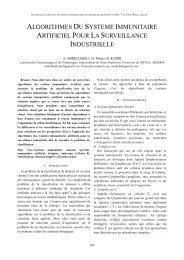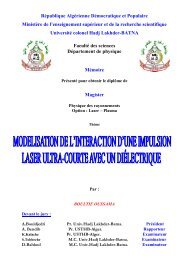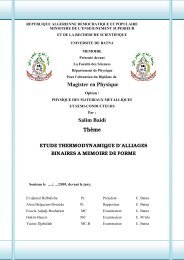- Page 1 and 2: Europe's Quest for the Universe Lod
- Page 3 and 4: Cover: THE VLT Array on the Paranal
- Page 6 and 7: Preface What a magnificent title,
- Page 8: Acknowledgements First of all I wou
- Page 11 and 12: 8 Europe’s quest for the Universe
- Page 13 and 14: 10 Europe’s quest for the Univers
- Page 15 and 16: 12 Europe’s quest for the Univers
- Page 17 and 18: 14 Europe’s quest for the Univers
- Page 19 and 20: 16 Europe’s quest for the Univers
- Page 21 and 22: 18 Europe’s quest for the Univers
- Page 23 and 24: 20 Europe’s quest for the Univers
- Page 25: 22 Europe’s quest for the Univers
- Page 29 and 30: 26 Europe’s quest for the Univers
- Page 31 and 32: 28 Europe’s quest for the Univers
- Page 33 and 34: 30 Europe’s quest for the Univers
- Page 35 and 36: 32 Europe’s quest for the Univers
- Page 37 and 38: 34 Europe’s quest for the Univers
- Page 39 and 40: 36 Europe’s quest for the Univers
- Page 41 and 42: 38 Europe’s quest for the Univers
- Page 43 and 44: 40 Europe’s quest for the Univers
- Page 45 and 46: 42 Europe’s quest for the Univers
- Page 47 and 48: 44 Europe’s quest for the Univers
- Page 49 and 50: 46 Europe’s quest for the Univers
- Page 51 and 52: 48 Europe’s quest for the Univers
- Page 53 and 54: 50 Europe’s quest for the Univers
- Page 55 and 56: 52 Europe’s quest for the Univers
- Page 57 and 58: 54 Europe’s quest for the Univers
- Page 59 and 60: 56 Europe’s quest for the Univers
- Page 61 and 62: 58 Europe’s quest for the Univers
- Page 63 and 64: 60 Europe’s quest for the Univers
- Page 65 and 66: 62 Europe’s quest for the Univers
- Page 67 and 68: 64 Europe’s quest for the Univers
- Page 69 and 70: 66 Europe’s quest for the Univers
- Page 71 and 72: 68 Europe’s quest for the Univers
- Page 73 and 74: 70 Europe’s quest for the Univers
- Page 75 and 76: 72 Europe’s quest for the Univers
- Page 77 and 78:
74 Europe’s quest for the Univers
- Page 79 and 80:
76 Europe’s quest for the Univers
- Page 81 and 82:
78 Europe’s quest for the Univers
- Page 83 and 84:
80 Europe’s quest for the Univers
- Page 85 and 86:
82 Europe’s quest for the Univers
- Page 87 and 88:
84 Europe’s quest for the Univers
- Page 90 and 91:
VI. Sites for Telescopes The only r
- Page 92 and 93:
Sites for Telescopes 89 Because of
- Page 94 and 95:
Sites for Telescopes 91 Chile was t
- Page 96 and 97:
Sites for Telescopes 93 O. Heckmann
- Page 98 and 99:
Sites for Telescopes 95 It therefor
- Page 100 and 101:
Sites for Telescopes 97 Figure VI,
- Page 102 and 103:
Sites for Telescopes 99 testing an
- Page 104 and 105:
1.0 0.9 0.8 0.7 0.6 0.5 Sites for T
- Page 106 and 107:
Sites for Telescopes 103 atmospheri
- Page 108 and 109:
Sites for Telescopes 105 Table VI,
- Page 110:
Sites for Telescopes 107 In Chile e
- Page 113 and 114:
110 Europe’s quest for the Univer
- Page 115 and 116:
112 Europe’s quest for the Univer
- Page 117 and 118:
114 Europe’s quest for the Univer
- Page 119 and 120:
116 Europe’s quest for the Univer
- Page 121 and 122:
118 Europe’s quest for the Univer
- Page 123 and 124:
120 Europe’s quest for the Univer
- Page 125 and 126:
122 Europe’s quest for the Univer
- Page 127 and 128:
124 Europe’s quest for the Univer
- Page 129 and 130:
126 Europe’s quest for the Univer
- Page 131 and 132:
128 Europe’s quest for the Univer
- Page 133 and 134:
130 Europe’s quest for the Univer
- Page 135 and 136:
132 Europe’s quest for the Univer
- Page 137 and 138:
134 Europe’s quest for the Univer
- Page 139 and 140:
136 Europe’s quest for the Univer
- Page 141 and 142:
138 Europe’s quest for the Univer
- Page 143 and 144:
140 Europe’s quest for the Univer
- Page 145 and 146:
142 Europe’s quest for the Univer
- Page 147 and 148:
144 Europe’s quest for the Univer
- Page 149 and 150:
146 Europe’s quest for the Univer
- Page 151 and 152:
148 Europe’s quest for the Univer
- Page 153 and 154:
150 Europe’s quest for the Univer
- Page 155 and 156:
152 Europe’s quest for the Univer
- Page 157 and 158:
154 Europe’s quest for the Univer
- Page 159 and 160:
156 Europe’s quest for the Univer
- Page 161 and 162:
158 Europe’s quest for the Univer
- Page 164 and 165:
X. Europe in Space: ESA’s Horizon
- Page 166 and 167:
Europe in Space: ESA’s Horizons 2
- Page 168 and 169:
Figure X, 1. The Horizons 2000 Prog
- Page 170 and 171:
Europe in Space: ESA’s Horizons 2
- Page 172 and 173:
Europe in Space: ESA’s Horizons 2
- Page 174 and 175:
Europe in Space: ESA’s Horizons 2
- Page 176 and 177:
Table X, 1. PI countries on ESA mis
- Page 178 and 179:
XI. European Space Missions: IR, X-
- Page 180 and 181:
Figure XI, 1. The ISO satellite. Th
- Page 182 and 183:
European Space Missions: IR, X- and
- Page 184 and 185:
European Space Missions: IR, X- and
- Page 186 and 187:
European Space Missions: IR, X- and
- Page 188 and 189:
European Space Missions: IR, X- and
- Page 190 and 191:
European Space Missions: IR, X- and
- Page 192 and 193:
European Space Missions: IR, X- and
- Page 194 and 195:
European Space Missions: IR, X- and
- Page 196 and 197:
Figure XI, 11. Quasars and other ex
- Page 198 and 199:
Table XI, 2. X- and γ-ray missions
- Page 200 and 201:
European Space Missions: IR, X- and
- Page 202 and 203:
European Space Missions: IR, X- and
- Page 204 and 205:
European Space Missions: IR, X- and
- Page 206 and 207:
XII. European Space Missions: The S
- Page 208 and 209:
European Space Missions: The Solar
- Page 210 and 211:
European Space Missions: The Solar
- Page 212 and 213:
European Space Missions: The Solar
- Page 214 and 215:
European Space Missions: The Solar
- Page 216 and 217:
European Space Missions: The Solar
- Page 218 and 219:
European Space Missions: The Solar
- Page 220:
European Space Missions: The Solar
- Page 223 and 224:
220 Europe’s quest for the Univer
- Page 225 and 226:
222 Europe’s quest for the Univer
- Page 227 and 228:
224 Europe’s quest for the Univer
- Page 229 and 230:
226 Europe’s quest for the Univer
- Page 231 and 232:
228 Europe’s quest for the Univer
- Page 233 and 234:
230 Europe’s quest for the Univer
- Page 235 and 236:
232 Europe’s quest for the Univer
- Page 237 and 238:
234 Europe’s quest for the Univer
- Page 239 and 240:
236 Europe’s quest for the Univer
- Page 241 and 242:
238 Europe’s quest for the Univer
- Page 243 and 244:
240 Europe’s quest for the Univer
- Page 245 and 246:
242 Europe’s quest for the Univer
- Page 247 and 248:
244 Europe’s quest for the Univer
- Page 249 and 250:
246 Europe’s quest for the Univer
- Page 251 and 252:
248 Europe’s quest for the Univer
- Page 253 and 254:
250 Europe’s quest for the Univer
- Page 256 and 257:
XVI. Publications Since verbal scie
- Page 258 and 259:
Publications 255 of the Royal Astro
- Page 260 and 261:
curious to see that even though mos
- Page 262 and 263:
1 0,8 0,6 0,4 0,2 0 -0,2 -0,4 -0,6
- Page 264 and 265:
Number of pages published annually
- Page 266 and 267:
0,45 0,4 0,35 0,3 0,25 0,2 0,15 0,1
- Page 268 and 269:
XVII. European Astronomy: Researche
- Page 270 and 271:
Relatively detailed information is
- Page 272 and 273:
European Astronomy: Researchers and
- Page 274 and 275:
European Astronomy: Researchers and
- Page 276 and 277:
European Astronomy: Researchers and
- Page 278 and 279:
European Astronomy: Researchers and
- Page 280 and 281:
XVIII. The Future Then was not non-
- Page 282 and 283:
The Future 279 of current interest.
- Page 284 and 285:
Ground based projects The Future 28
- Page 286 and 287:
contribute and receives a proportio
- Page 288 and 289:
There were also warnings that the f
- Page 290:
The Future 287 successful. Neverthe
- Page 293 and 294:
290 Europe’s quest for the Univer
- Page 295 and 296:
292 Europe’s quest for the Univer
- Page 297 and 298:
294 Europe’s quest for the Univer
- Page 299 and 300:
296 Europe’s quest for the Univer
- Page 301 and 302:
298 Europe’s quest for the Univer
- Page 303 and 304:
300 Europe’s quest for the Univer
- Page 305 and 306:
302 Europe’s quest for the Univer
- Page 307 and 308:
304 Europe’s quest for the Univer
- Page 309 and 310:
306 Europe’s quest for the Univer
- Page 311 and 312:
308 Europe’s quest for the Univer
- Page 313 and 314:
310 Europe’s quest for the Univer
- Page 315 and 316:
312 Europe’s quest for the Univer
- Page 317 and 318:
314 Europe’s quest for the Univer
- Page 320 and 321:
A AAT, 40 Abbot C.G., 91 active opt
- Page 322 and 323:
Effelsberg, 142 EFOSC, 32 Einstein,
- Page 324 and 325:
Linde, 75 LISA, 164, 165, 170, 240-
- Page 326:
STEREO, 227 STIS, 126 Stock J., 91,
- Page 329:
Achevé d’imprimer sur les presse






